CHEVROLET EXPRESS 1998 1.G Workshop Manual
Manufacturer: CHEVROLET, Model Year: 1998, Model line: EXPRESS, Model: CHEVROLET EXPRESS 1998 1.GPages: 386, PDF Size: 20.74 MB
Page 51 of 386
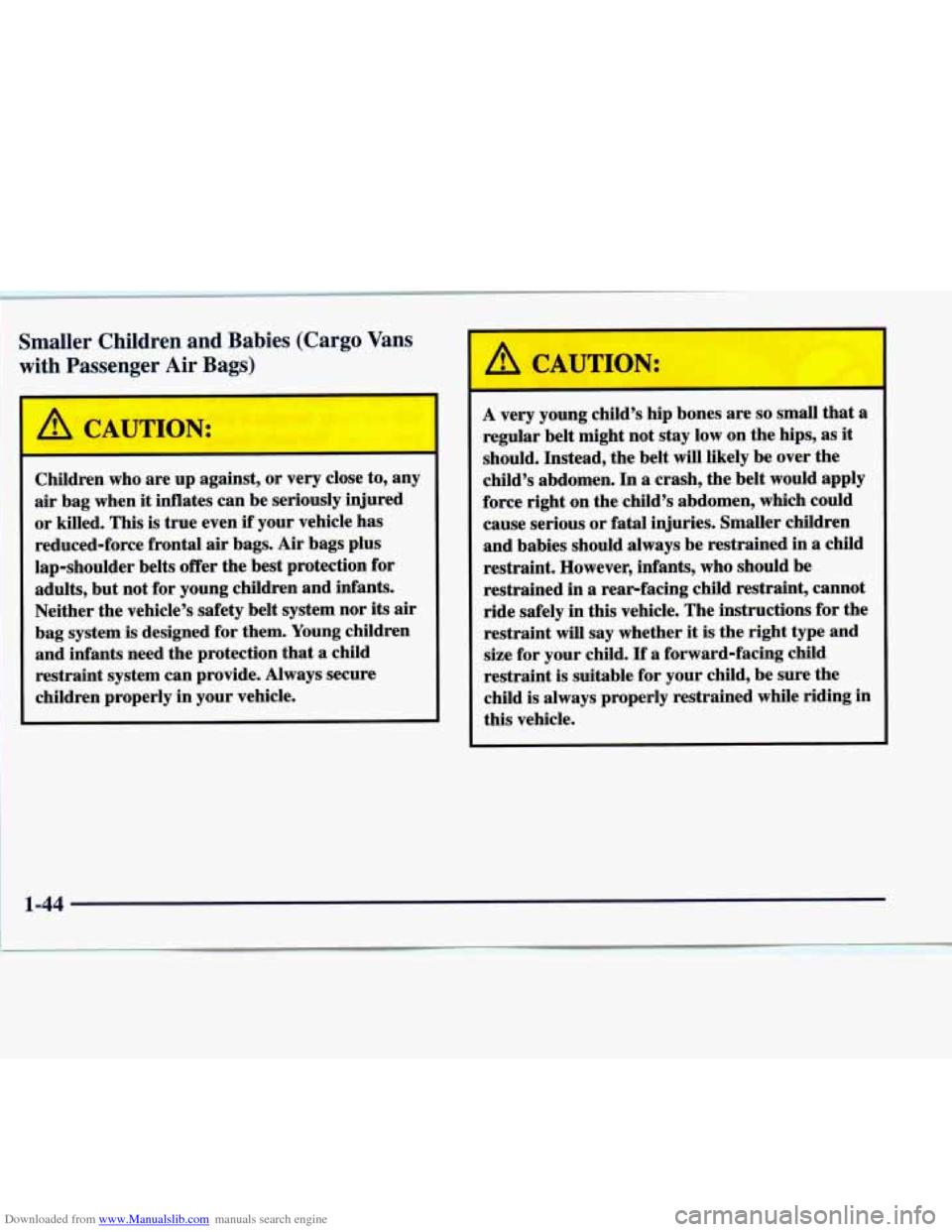
Downloaded from www.Manualslib.com manuals search engine 1 Smaller Children and Babies (Cargo Vans
with Passenger Air Bags)
r
Children who are up against, or very close to, any
air bag when it inflates can be seriously injured
or killed. This is true even if your vehicle has
reduced-force frontal air bags. Air bags plus
lap-shoulder belts offer the best protection for
adults, but not for young children and infants.
Neither the vehicle’s safety belt system nor its air
bag system is designed for them. Young children
and infants need the protection that a child
restraint system can provide. Always secure
children properly in your vehicle.
A CL-. ON:
A very young child’s hip bones are so small that a
regular belt might not stay low on the hips,
as it
should. Instead, the belt
will likely be over the
child’s abdomen. In
a crash, the belt would apply
force right on the child’s abdomen, which could
cause serious or fatal injuries. Smaller children
and babies should always be restrained in a child
restraint. However, infants, who should be
restrained in a rear-facing child restraint, cannot
ride safely in this vehicle. The instructions for the
restraint will say whether it
is the right type and
size for your child.
If a forward-facing child
restraint is suitable for your child, be sure the
child is always properly restrained while riding in
this vehicle.
1-44
Page 52 of 386
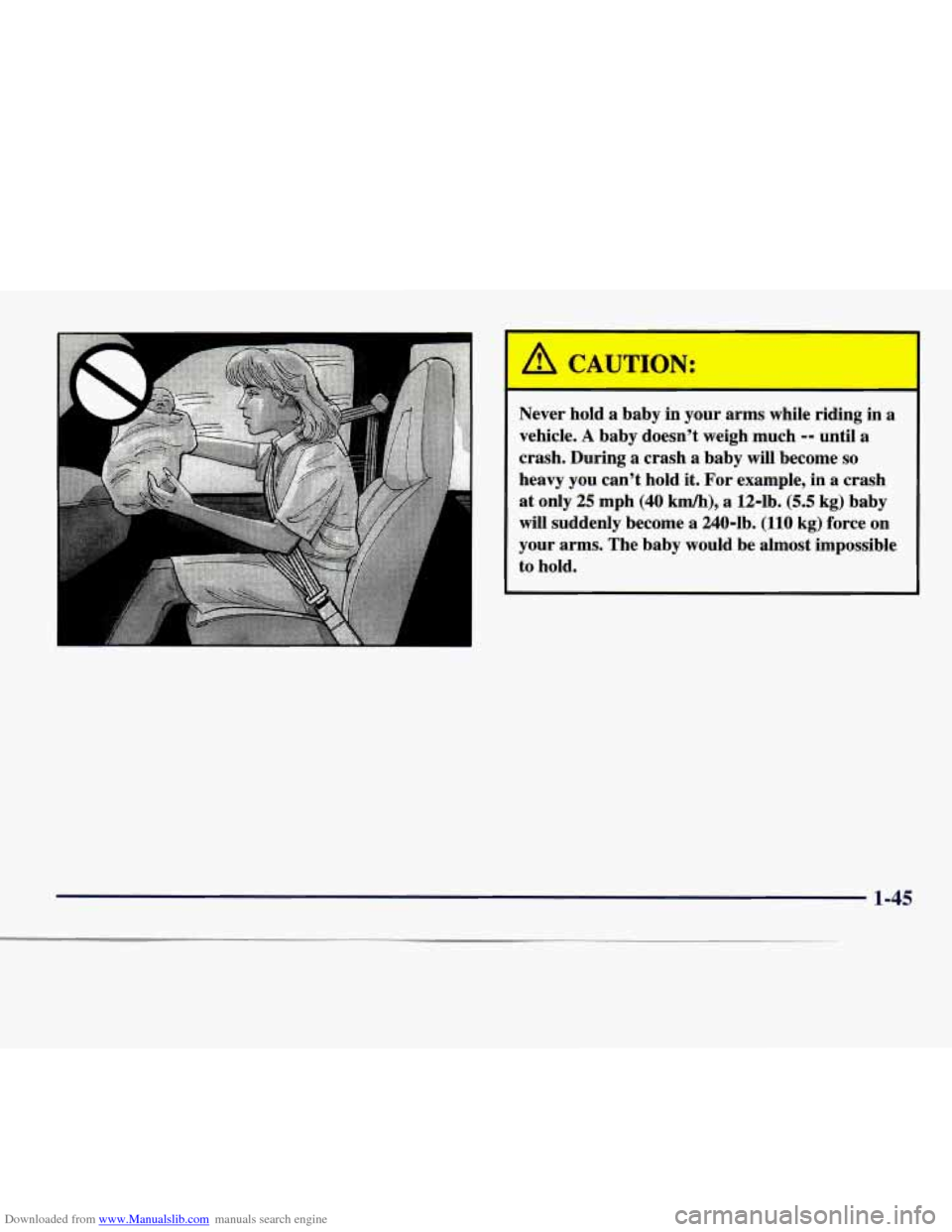
Downloaded from www.Manualslib.com manuals search engine Never hold a baby in your arms while riding in a
vehicle. A baby doesn’t weigh much -- until a
crash. During a crash a baby will become so
heavy you can’t hold it. For example, in a crash
at only 25 mph (40 km/h), a 12-1b. (5.5 kg) baby
will suddenly become a 240-1b. (110 kg) force on
your arms. The baby would be almost impossible
to hold.
1-45
Page 53 of 386
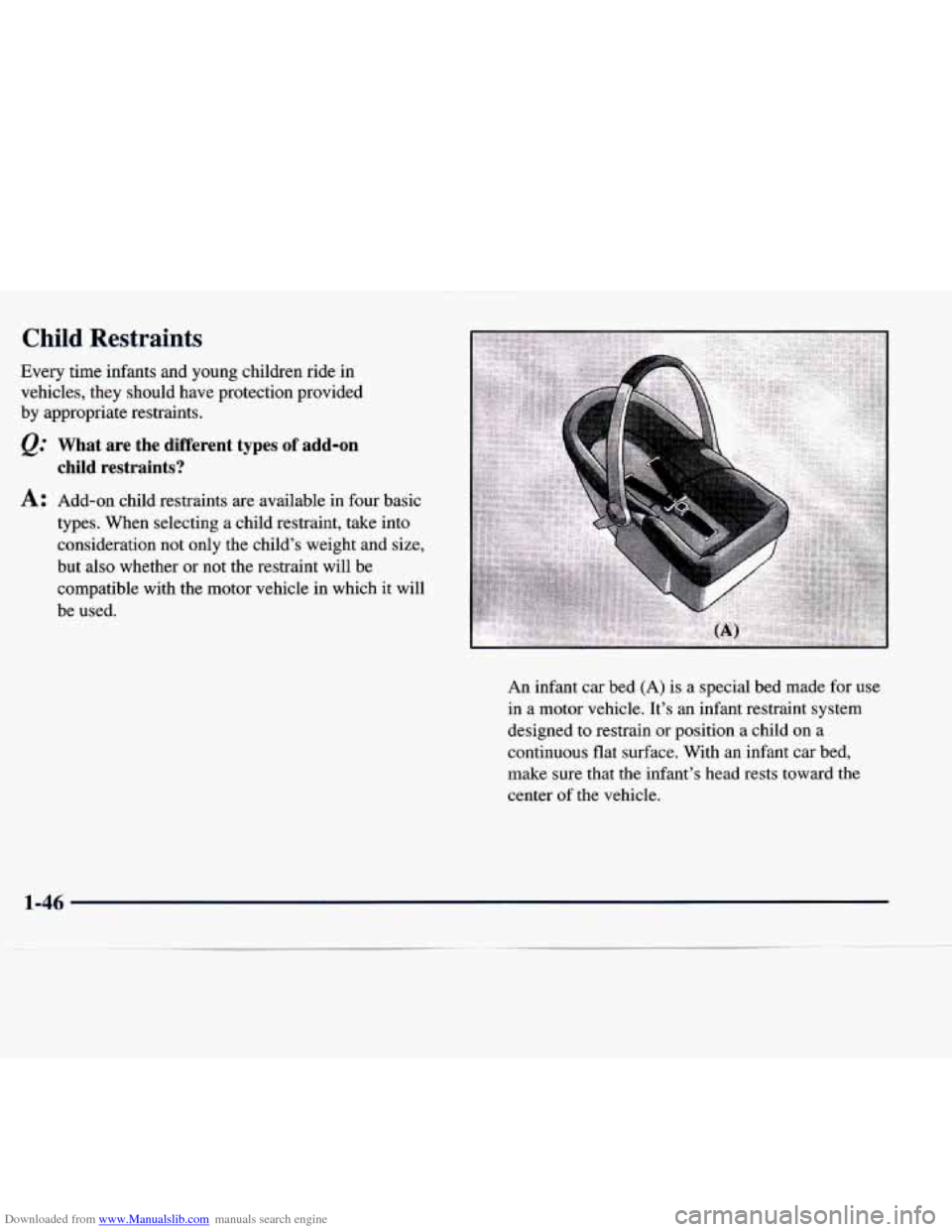
Downloaded from www.Manualslib.com manuals search engine Child Restraints
Every time infants and young children ride in
vehicles, they should have protection provided
by appropriate restraints.
@ What are the different types of add-on
A: Add-on child restraints are available in four basic
types. When selecting a child restraint,
take into
consideration not only the child’s weight and size,
but also whether or not the restraint will be
compatible with the motor vehicle in which it will
be used.
child restraints?
An infant car bed (A) is a special bed made for use
in a motor vehicle. It’s an infant restraint system
designed to restrain or position a child on a
continuous flat surface. With an infant car bed,
make
sure that the infant’s head rests toward the
center of the vehicle.
1-46
Page 54 of 386
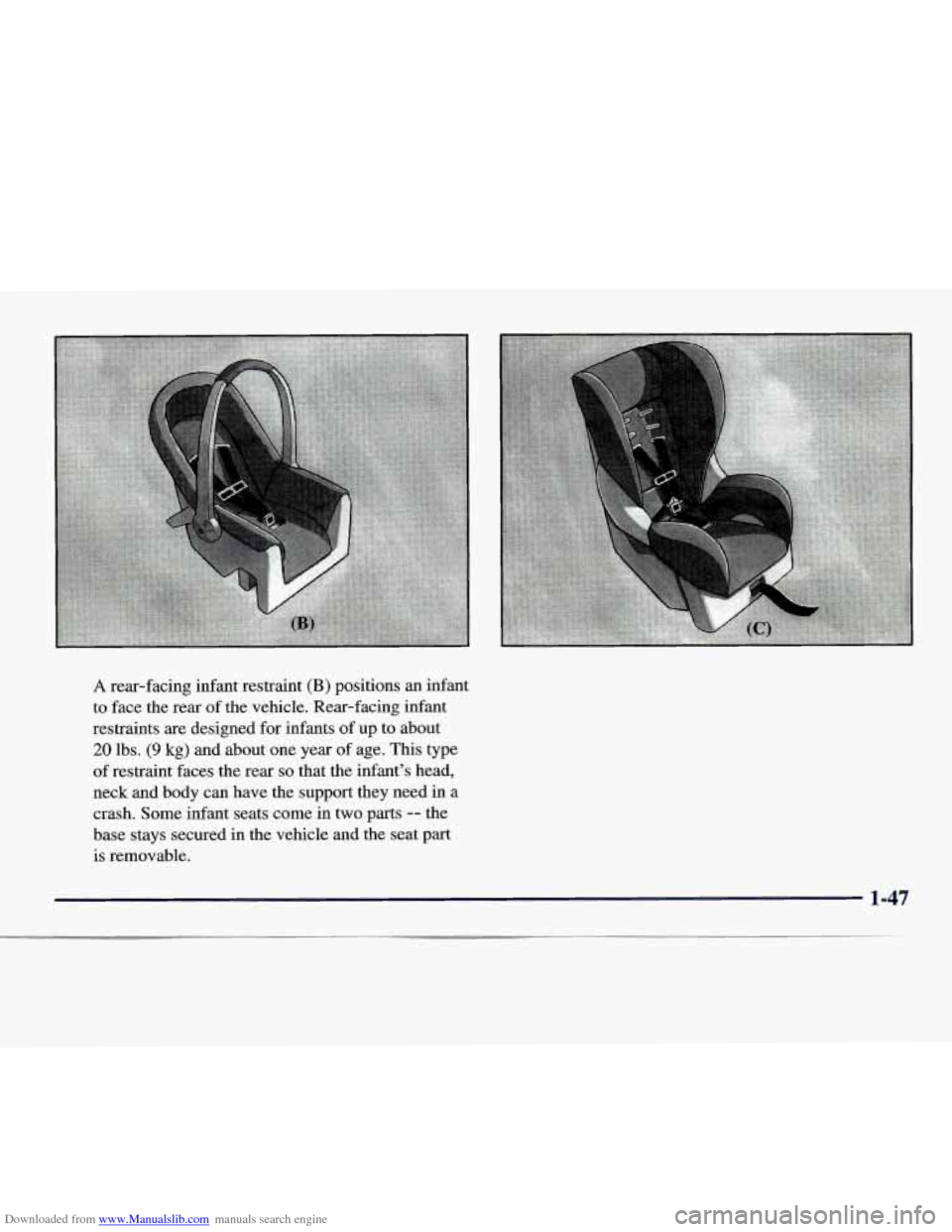
Downloaded from www.Manualslib.com manuals search engine A rear-facing infant restraint (B) positions an infant
to face the rear
of the vehicle. Rear-facing infant
restraints are designed for infants of up to about
20 lbs. (9 kg) and about one year of age. This type
of restraint faces the rear so that the infant’s head,
neck and body can have the support they need in a
crash. Some infant seats come in two parts
-- the
base stays secured in the vehicle and the seat part
is removable.
1-47
Page 55 of 386
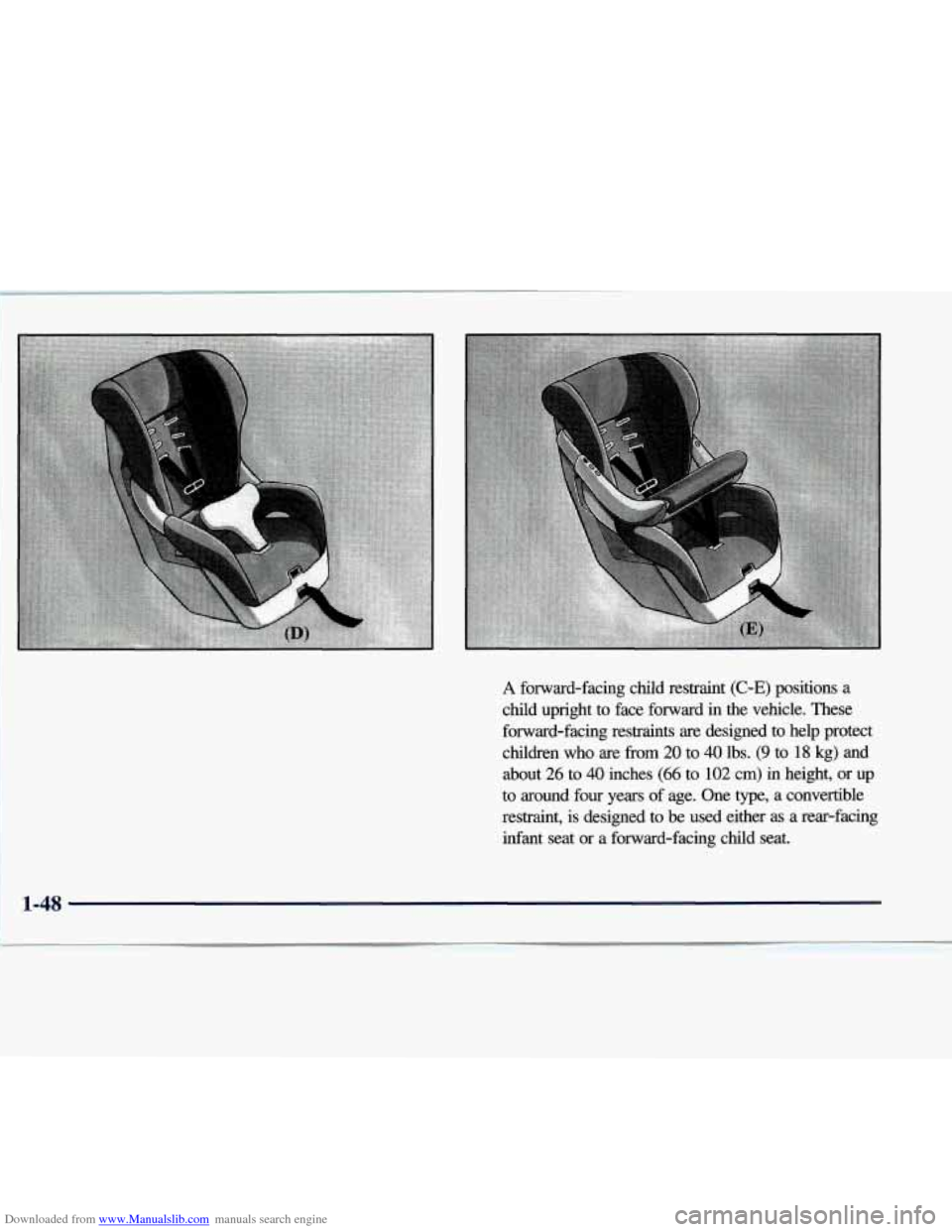
Downloaded from www.Manualslib.com manuals search engine A forward-facing child restraint (C-E) positions a
child upright
to face forward in the vehicle. These
forward-facing restraints are designed to help protect
children who are from
20 to 40 lbs. (9 to 18 kg) and
about
26 to 40 inches (66 to 102 cm) in height, or up
to around four years of age. One
type, a convertible
restraint, is designed to be used either as a rear-facing
infant seat or a forward-facing child seat.
1-48
Page 56 of 386
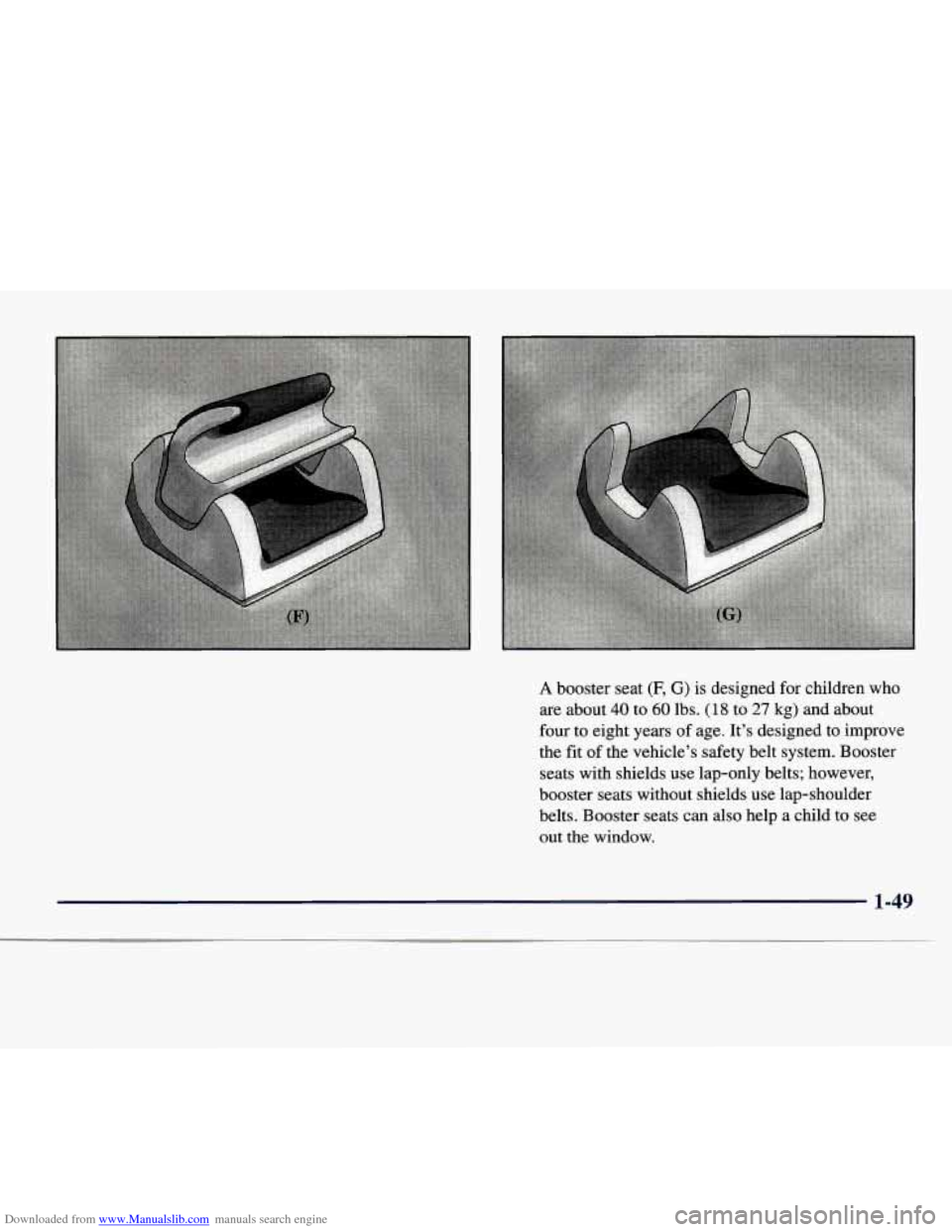
Downloaded from www.Manualslib.com manuals search engine i
A booster seat (F, G) is designed for children who
are about
40 to 60 lbs. (1 8 to 27 kg) and about
four to eight years of age. It’s designed to improve
the fit
of the vehicle’s safety belt system. Booster
seats with shields use lap-only belts; however,
booster seats without shields use lap-shoulder
belts. Booster seats
can also help a child to see
out the window.
1-49
Page 57 of 386
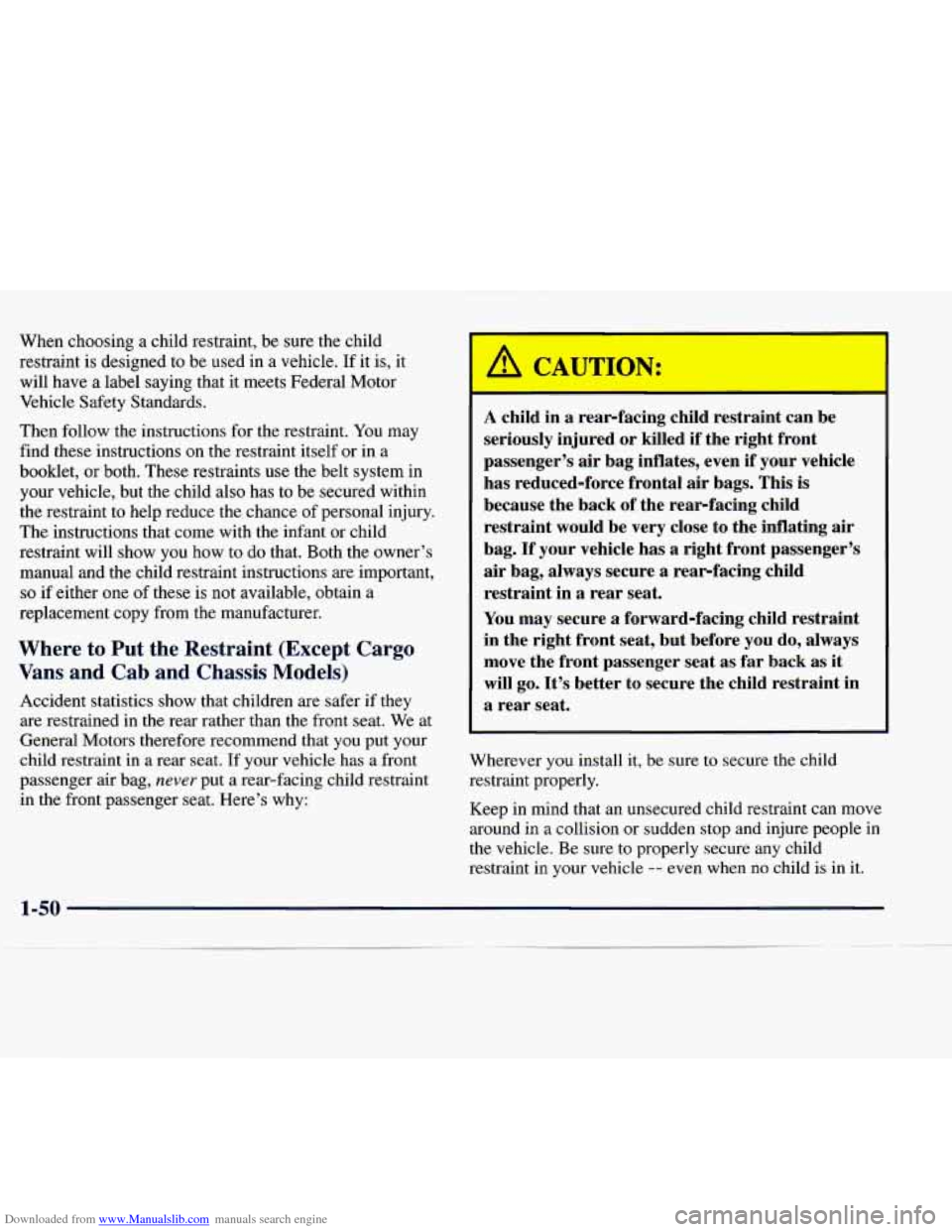
Downloaded from www.Manualslib.com manuals search engine When choosing a child restraint, be sure the child
restraint is designed to be used in a vehicle.
If it is, it
will have
a label saying that it meets Federal Motor
Vehicle Safety Standards.
Then follow the instructions for the restraint.
You may
find these instructions on the restraint itself or in
a
booklet, or both. These restraints use the belt system in
your vehicle, but the child also has
to be secured within
the restraint
to help reduce the chance of personal injury.
The instructions that come with the infant or child
restraint will show
you how to do that. Both the owner’s
manual and the child restraint instructions are important,
so if either one of these is not available, obtain a
replacement copy from the manufacturer.
Where to Put the Restraint (Except Cargo
Vans and Cab and Chassis Models)
Accident statistics show that children are safer if they
are restrained in the rear rather than the front seat. We at
General Motors therefore recommend that you put your
child restraint in a rear seat.
If your vehicle has a front
passenger air bag,
never put a rear-facing child restraint
in the front passenger seat. Here’s why:
A child in a rear-facing child restraint can be
seriously injured or killed if the right front
passenger’s air bag inflates, even
if your vehicle
has reduced-force frontal air bags. This
is
because the back of the rear-facing child
restraint would be very close to the inflating air
bag.
If your vehicle has a right front passenger’s
air bag, always secure a rearfacing child
restraint in a rear seat.
You may secure a forward-facing child restraint
in the right front seat, but before you do, always
move the front passenger seat as far back
as it
will go. It’s better to secure the child restraint in
a rear seat.
Wherever you install
it, be sure to secure the child
restraint properly.
Keep in mind that an unsecured child restraint can move
around in a collision or sudden stop and injure people
in
the vehicle. Be sure to properly secure any child
restraint in your vehicle
-- even when no child is in it.
Page 58 of 386
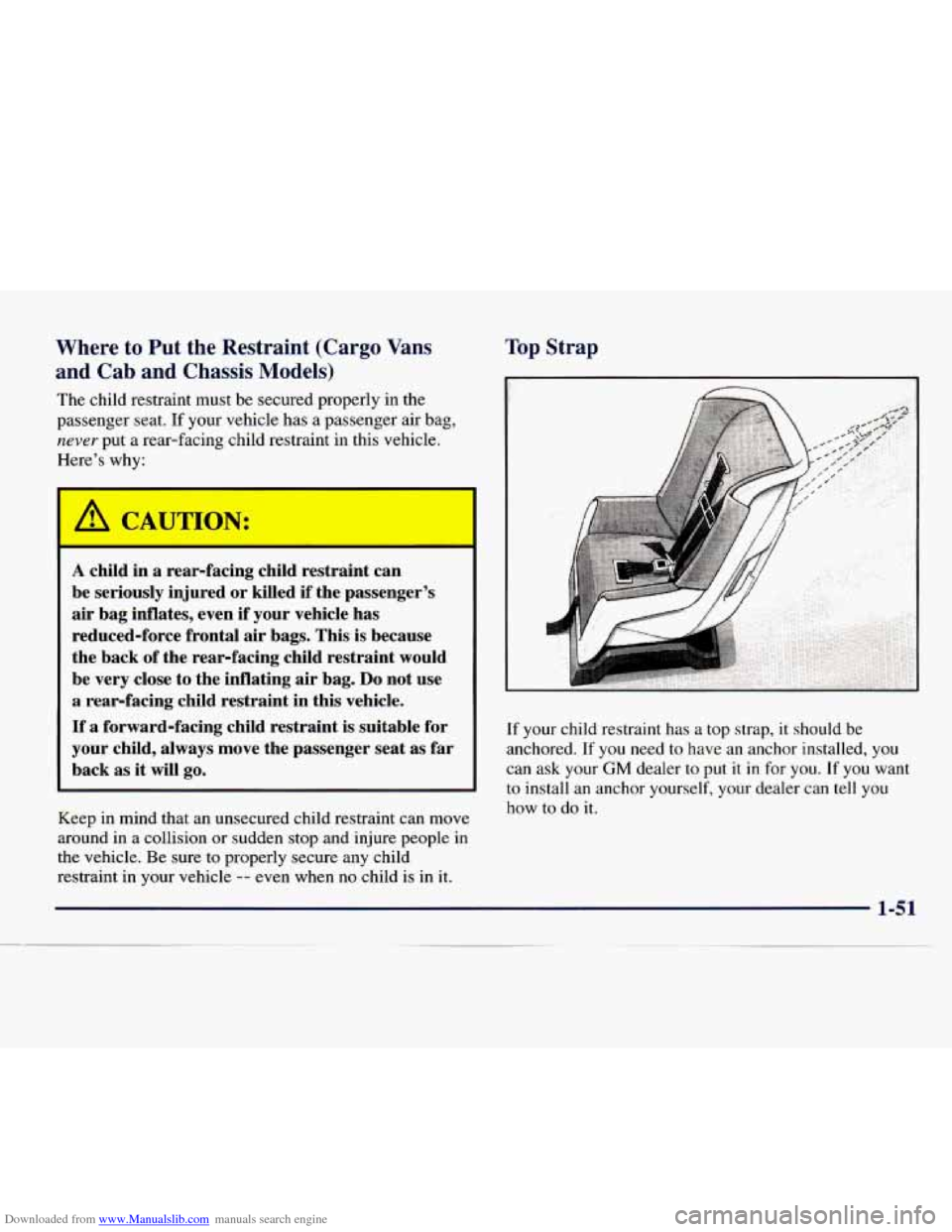
Downloaded from www.Manualslib.com manuals search engine Where to Put the Restraint (Cargo Vans
and Cab and Chassis
Models)
The child restraint must be secured properly in the
passenger seat.
If your vehicle has a passenger air bag,
never put a rear-facing child restraint in this vehicle.
Here's why:
I ' A CAUTIO€'
A child in a rear-facing child restraint can
be seriously injured or killed if the passenger's
air bag inflates, even if your vehicle has
reduced-force frontal air bags. This is because
the back of the rear-facing child restraint would
be very close
to the inflating air bag. Do not use
a rear-facing child restraint in this vehicle.
If a forward-facing child restraint is suitable for
your child, always move the passenger seat as far
back as it will go.
Keep in mind that an unsecured child restraint can move
around in a collision or sudden stop and injure people
in
the vehicle. Be sure to properly secure any child
restraint in your vehicle
-- even when no child is in it.
Top Strap
If your child restraint has a top strap, it should be
anchored.
If you need to have an anchor installed, you
can ask your
GM dealer to put it in for you. If you want
to install an anchor yourself, your dealer can tell you
how
to do it.
Page 59 of 386
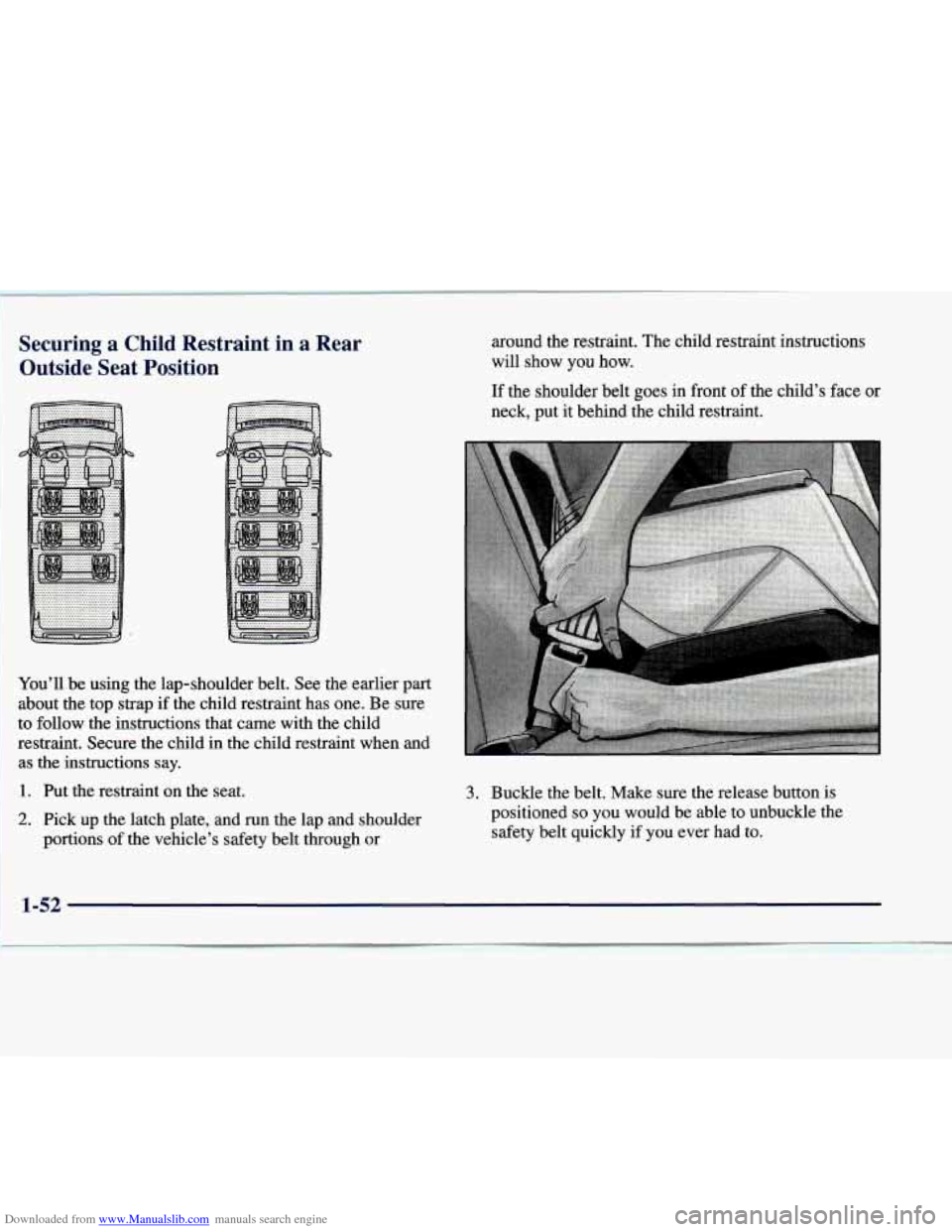
Downloaded from www.Manualslib.com manuals search engine Securing a Child Restraint in a Rear Outside Seat Position around the restraint. The child restraint instructions
will show you how.
You’ll be using the lap-shoulder belt. See the earlier part
about the top strap
if the child restraint has one. Be sure
to
follow the instructions that came with the child
restraint. Secure the child in the child restraint when and
as the instructions say.
1. Put the restraint on the seat.
2. Pick up the latch plate, and run the lap and shoulder
portions of the vehicle’s safety belt through or
If the shoulder belt goes in front of the child’s face or
neck, put it behind the child restraint.
3. Buckle the belt. Make sure the release button is
positioned
so you would be able to unbuckle the
safety belt quickly
if you ever had to.
1-52
Page 60 of 386
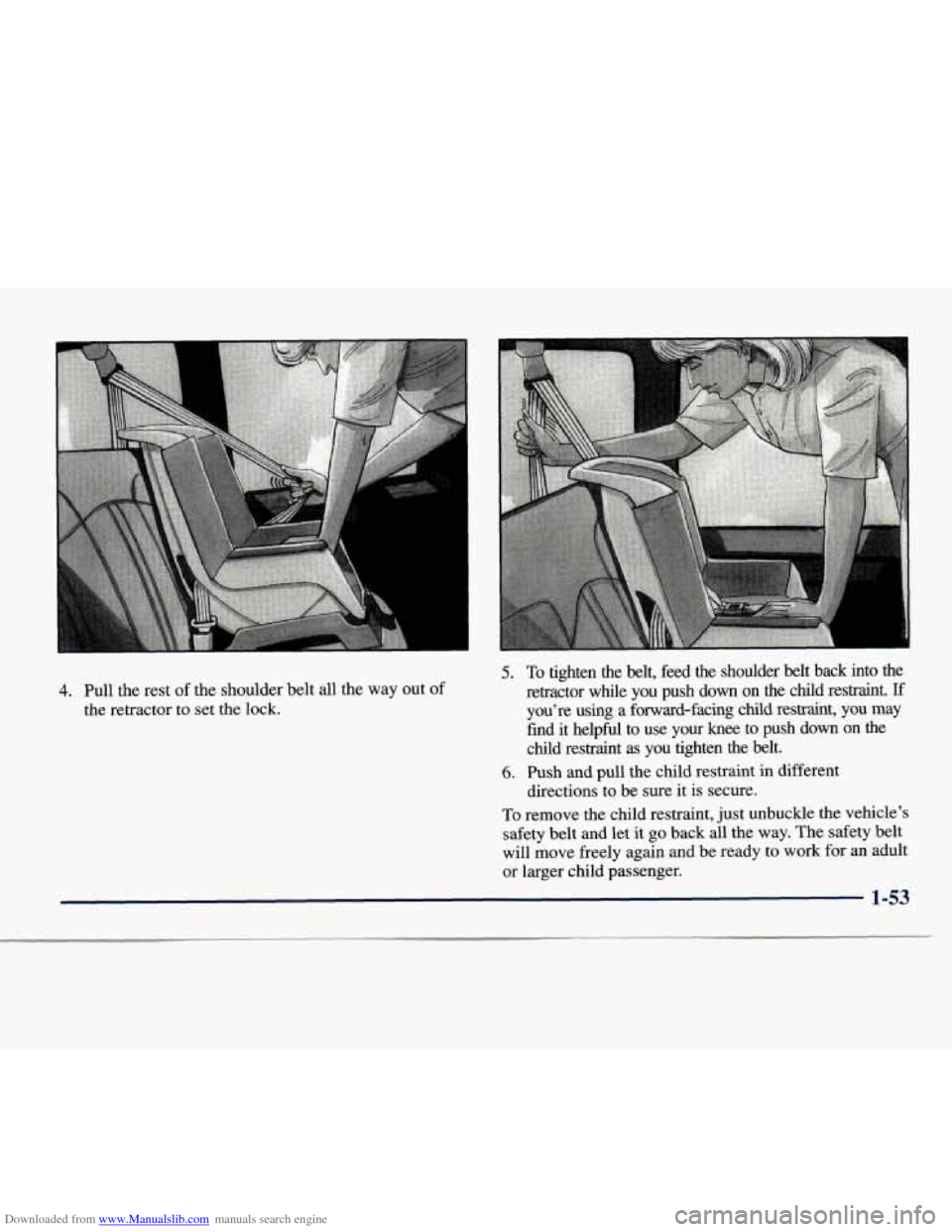
Downloaded from www.Manualslib.com manuals search engine 4. Pull the rest of the shoulder belt all the way out of
the retractor to set the lock.
5. To tighten the belt, feed the shoulder belt back into the
retractor while you push down on the child restraint.
If
you’re using a forward-facing child restraint, you may
find it helpful to use your
knee to push down on the
child restraint
as you tighten the belt.
directions to be sure it is secure.
6. Push and pull the child restraint in different
To remove the child restraint, just unbuckle the vehicle’s
safety belt and let it
go back all the way. The safety belt
will move freely again and be ready to work for an adult
or larger child passenger.
1-53